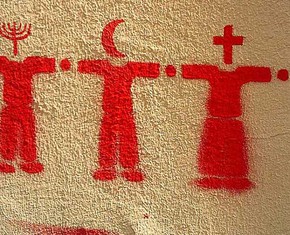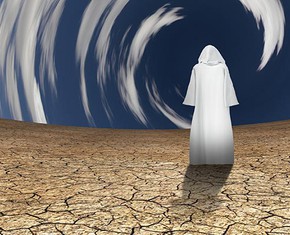The views expressed in our content reflect individual perspectives and do not represent the authoritative views of the Baha'i Faith.
What connection does ancient Zoroastrianism, the state religion of the pre-Islamic Persian empires for more than a thousand years, have to the Baha’i Faith?
In the previous article in this series, we looked at a set of Zoroastrian prophecies that foretold the successive appearance of three future Zoroastrian saviors, or messiahs, each of whom would command the sun to stand still in the middle of the sky for 10, 20 and 30 days, respectively.
Then we cited Abdu’l-Baha’s fascinating interpretation of those mysterious, enigmatic prophecies. Briefly, Abdu’l-Baha explained that the three saviors were the prophets Muhammad, the Bab and Baha’u’llah.
While this elucidation of Zoroastrian prophecy does not conform to the popular expectations of many Zoroastrians themselves – who generally regard these future saviors as Zoroastrian messiahs who would restore the benighted Zoroastrian religion to its former glory – Abdu’l-Baha’s interpretation is consistent with historical reality, especially with the subsequent history of religions in Persian and present-day Iran.
The symbolism of these prophecies shows that when the sun stands still, it does so, at its zenith in the middle of the sky, enlightening and giving life to the world in its full splendor and plenitude, undiminished during the period of time that each of the three Zoroastrian saviors’ influence prevails.
The overall correlation between those prophetic “days” and their corresponding durations in terms of years isn’t mathematically precise, yet it explains the picture portrayed by the Zoroastrian prophecies themselves. The prophecies themselves are far from consistent, especially when compared with similar texts, because they’re symbolic, not precise. They point forward, creating and sustaining popular expectations among Zoroastrians about their future fulfillment – but in a vague, imprecise way.
Note also that these Zoroastrian prophecies represent the aspirations – what some historians of religion refer to as “wish-images” – of the Zoroastrians themselves, after suffering successive conquests by foreign invaders. When the former glory and dominance of the Zoroastrian religion became a thing of the past, naturally the remaining Zoroastrians longed for the restoration of their Faith in the apocalyptic future. Such prophecies are part and parcel of religious texts that some scholars regard as “crisis literature,” where God is represented as vanquishing the foreign conquerors in the distant future, since this is impossible in the historical present back then. Thus the injustices that befell Zoroastrians historically would be redressed eschatologically – in the Last Day, at the end of history, when the oppressors would be overcome and punished, and the oppressed Zoroastrians would be liberated and what they lost would be restored.
Like dreams, apocalyptic prophecies require interpretation. Such interpretations, if authoritative, function as declarations of fulfillment. Time foretold becomes actual time and place. The prophetic dream comes true – but in a different way, not as expected. This is what is happened in the case of Abdu’l-Baha’s interpretation of the prophecies of the three Zoroastrian saviors, as cited above.
While prophecies point to the future, they do not predetermine the future course of events. The future interprets that past, with hindsight superior to foresight, both of which are informed and enlightened by profound insight.
Of course, the Zoroastrian prophecies did not turn out as expected. They were not literally fulfilled. But a far greater fulfillment is what actually took place – the birth of a new world religion, the Baha’i Faith, which honors and immortalizes the prophet Zoroaster as among the recognized series of God’s messengers, within a world religion global in scope and outlook, rather than national or regional in its influence, which was the case with Zoroastrianism. Baha’u’llah, the prophet and founder of the Baha’i Faith, honored the prophet Zoroaster as “Him Who is the Spirit of purity”:
… Hindus and Zoroastrians do not permit or welcome outsiders who wish to join their ranks. This runneth counter to the purpose underlying the advent of the Messengers of God and to that which hath been revealed in their Books. For those Who have appeared at God’s behest have been entrusted with the guidance and education of all people. … The [Zoroastrian] fire-temples of the world stand as eloquent testimony to this truth. In their time they summoned, with burning zeal, all the inhabitants of the earth to Him Who is the Spirit of purity [Zoroaster]. – Baha’u’llah, Tabernacle of Unity, p. 42.
If “the magnitude of the Baha’i cycle,” as Abdu’l-Baha explained in the passage quoted in the previous article, is such that its duration will “extend over a period of at least five hundred thousand years,” then so also will the name and the spiritual principles of Zoroaster. Baha’u’llah proclaimed to Zoroastrian priests in particular, and to Zoroastrians in general:
“O high priests! Ears have been given you that they may hearken unto the mystery of Him Who is the Self-Dependent, and eyes that they may behold Him. Wherefore flee ye? The Incomparable Friend is manifest. He speaketh that wherein lieth salvation. Were ye, O high priests, to discover the perfume of the rose garden of understanding, ye would seek none other but Him, and would recognize, in His new vesture, the All-Wise and Peerless One, and would turn your eyes from the world and all who seek it, and would arise to help Him. …
The Hand of Omnipotence is stretched forth from behind the clouds; behold ye it with new eyes. The tokens of His majesty and greatness are unveiled; gaze ye on them with pure eyes … Say, O high priests! Ye are held in reverence because of My Name, and yet ye flee Me! Ye are the high priests of the Temple. Had ye been the high priests of the Omnipotent One, ye would have been united with Him, and would have recognized Him …. Say, O high priests! No man’s acts shall be acceptable, in this Day, unless he forsaketh mankind and all that men possess, and setteth his face towards the Omnipotent One. – Baha’u’llah, translated by Shoghi Effendi in The Promised Day Is Come, pp. 77–78.
Sometimes, when something expected does not happen, what actually happens may be better than expected.
Note: You can read a full discussion of Zoroastrian prophecies and their Baha’i interpretation here: Christopher Buck, “Baha’u’llah as Zoroastrian Saviour.” Baha’i Studies Review 8 (1998): 14–33, http://bahai-library.com/pdf/b/buck_zoroastrian.pdf.
















Comments
Sign in or create an account
Continue with Googleor